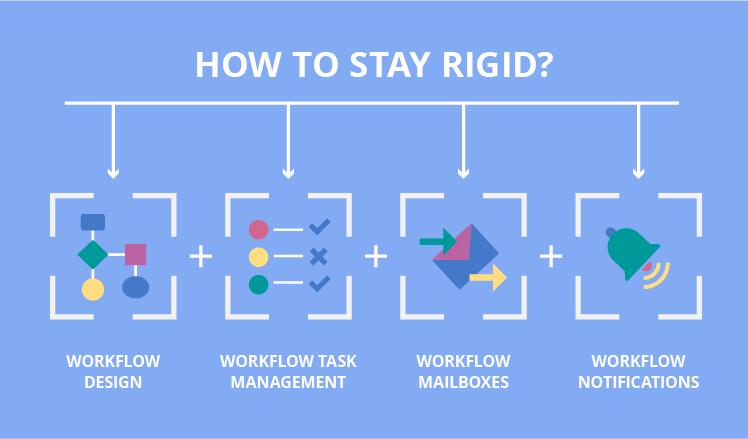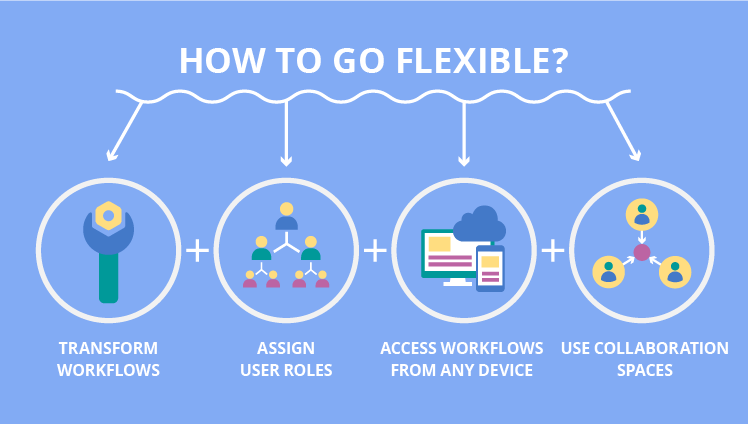SharePoint workflows: staying rigid or going flexible?
Transforming unstructured business processes into effective workflows is the first thing companies do in order to enhance their productivity. Let's admit, today's IT market is full of workflow management solutions that promise rich sets of features and almost instant results in the bottom line. The challenge here is to get the system that will streamline your workflows and let you stay flexible enough to keep up with your business development and employees' demands.
SharePoint is one of the tools to meet the requirement, since on the one hand it safeguards the rigid workflow structure and, on the other hand, offers flexibility to adjust processes according to the needs. This way, SharePoint not only lets employees fulfil their tasks step by step, but helps them to understand the entire process better and take control of the workflow cycle.
How to stay rigid?
Being formal structures, workflows require well-defined and coordinated actions from their participants. This is a rare case when being rigid doesn't mean being backward-looking. On the contrary, a precise workflow structure is required for employees to fulfill their tasks to the fullest productivity with the least time and efforts required. What's more important, any deviation from a process may result in mistakes, postponing of tasks and even a workflow failure.
By choosing SharePoint as your workflow management tool, you can build a workflow's precise structure by identifying its steps and assigning responsible people at every stage. Moreover, owing to SharePoint features, employees can handle all workflow-related processes in a single location, thus be more focused and organized.
Below, here are some of the features that allow building effective SharePoint workflows and stay tuned to the working process.

Workflow design tools will help you to create precise workflow structures in compliance with your enterprise's business processes. SharePoint represents a workflow as a sequence of events, steps, conditions and actions, which can be grouped in any order. This way, SharePoint enables modeling business processes of different complexities.
It's possible to automate basic procedures (e.g. document approval) with out-of-the-box SharePoint workflows. In the platform's latest versions there are five pre-programmed workflow types, which are approval, collect feedback, collect signatures, three-state and publishing approval.
To create more sophisticated workflows, you can use Visual Studio that offers the entire palette of workflow elements (DoWhile, PickBranch, Sequence, Switch, etc.) that help to build the workflow perfectly meeting your requirements. One more possibility is to enrich your SharePoint site with a workflows management add-in that will let you control all the running workflows, identify errors, resume or suspend certain workflow instances, etc.
Workflow task management is a SharePoint feature that is valuable for team leaders above all, as it allows assigning tasks and controlling their accomplishment. But this functionality is also very important for employees themselves, as it enables them to see all the tasks in a well-defined structure, so they can plan their activities and prioritize important tasks.
Workflow mailboxes help to structure workflow-related emails and not to lose them in the inbox. Dedicated SharePoint site mailboxes can be created in the heart of your email system. This way, workflow participants granted with relevant permissions can open up a dedicated site mailbox with the emails on a certain project and access the information at any time.
Workflow notifications keep SharePoint workflow participants aware of all the changes in a workflow, which prevents them from checking their team site constantly. Once a new document or a new task appears, the system sends an automatic email message to workflow participants, so that they can see the update immediately.
All the above mentioned SharePoint features enable users to strictly follow a workflow and be involved in the process. It also lets managers control the entire process, detect weak points and make corrections when needed.
How to go flexible?

The workflows' rigidity doesn't mean your workflow management system should be rigid as well. Flexibility is what you need to go in line with changeable business environment and satisfy workflow participants. SharePoint facilitates workflow management significantly by enabling users to:
- Transform a workflow. Once created, workflows rarely stay unchanged for years. Business processes often dictate new rules, so workflows should be adjusted accordingly. In this case you can customize the existing workflow by adding new steps or changing the sequence of actions (e.g. using SharePoint Designer or Visual Studio). It's also possible to start a new workflow from scratch. If you need more complex workflows with sophisticated architecture, it's highly recommended to address your requirements to dedicated SharePoint consultants who will create SharePoint workflows that correspond your business scale.
- Assign user roles. Whether you have new workflow participants or want to change their roles, no difficult manipulations are needed, as role-based workflows are one of the strongest SharePoint's sides. Owing to the user hierarchy that you can build in SharePoint, it's possible to control the depth of a user's participation in a workflow by granting wider rights or limiting the access to specific activities.
- Follow workflows 24/7. With SharePoint, users are able to follow workflows constantly without being bound to their PC. Both cloud and mobile versions of your SharePoint workflows allow users to take part in an uninterrupted business process whenever they are and not to drop out of the workflow chain.
- Use workflow collaboration spaces, which are necessary if several parties (teams, departments, work groups) are involved into SharePoint workflows. SharePoint collaboration spaces is a real godsend for team work, as they help to build targeted collaboration without mixing separate processes, as well as let the participants communicate at any moment, thus preventing workflow interruption and randomness.
This way, SharePoint flexibility contributes greatly to successful accomplishment of workflow, as their participants are always free to tailor the entire workflow model to the actual business needs or to adopt to the existing workflow structure by applying dedicated tools.
Conclusion
Searching for a workflow management tool, it's easy to fall for over-promising solutions promising to handle any workflow and provide instant benefits. Still, it's reasonable to analyze first if the solution can keep the workflow structure both rigid and flexible. SharePoint is the platform that successfully meets this requirement, as it copes with workflows of any complexity and provides its users with a full set of tools to keep up with varying business conditions.

